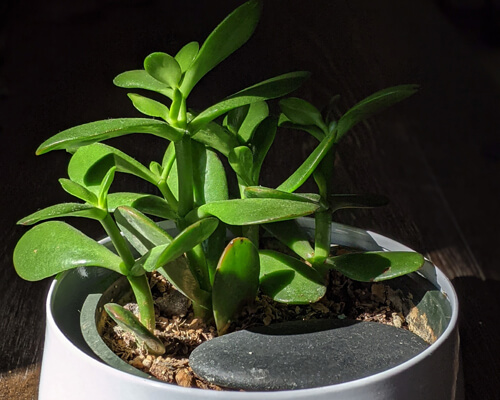How to repot a snake plant?

If you’ve ever wondered how to repot a snake plant, this guide is for you. We will discuss the signs of when to repot, along with detailed steps and expert tips. All this ensures the smooth transition of your plant to its new home, fostering continued growth and happiness.
When to repot a snake plant?
Repotting your snake plant is an important part of keeping it healthy and happy. You should repot every two to three years, as the plant will outgrow its current pot over time.
The best time to repot is in the spring when your snake has plenty of energy for new growth.
Since these plants are resilient, you can even repot them with some soil from their original potting mix.
However, to ensure that your snake stays healthy over time, it’s best to switch to a fresh soil mix.
Repotting also presents a perfect opportunity to check the roots for signs of disease or infestation.
It’s important that they stay healthy too. If you don’t repot often enough, the soil can become compacted and make it difficult for nutrients and water to get through.
So don’t forget to repot your snake plant every two or three years.
5 Signs Your Snake Plant Needs To Be Repotted
1. Roots Visible Through the Drainage Holes
If you can see the roots of your snake plant coming out through the drainage holes of its pot, then it’s time to give it some extra space.
When a plant is rootbound, it means that there is not enough room for the roots to grow and spread out.
This can cause the plant to become stressed and not grow as well.
2. Poor Drainage
Poor drainage is a sign that the soil has become too compacted for water to move through it properly, leading to root rot or other problems.
If you notice your snake plant’s leaves drooping after watering, then it’s time to repot into a larger pot with fresh soil.
3. Plant Is Top-Heavy
If you notice your snake plant starting to lean towards one side or the other, it may be because the root system is not strong enough to hold up the foliage above it.
This is another sign that it’s time to repot into a larger pot with fresh soil.
4. Plant Is Not Growing
If your snake plant hasn’t grown in height or width for more than a year, then it is likely rootbound and needs to be repotted.
5. Plant Has Outgrown Its Pot
If you notice that the diameter of your snake plant is larger than the diameter of its pot, then it’s a sure sign that it needs to be repotted.
How to repot a snake plant: a step-by-step guide
Step 1. Start with the right materials. Gather a new pot, fresh soil mix and some tools such as pruning shears, a trowel, gloves, and newspaper or other covering to avoid making a mess.
Make sure to choose a pot that is slightly larger than the current one – usually two inches in diameter will do.
Step 2. Remove the snake plant from its pot, being careful not to damage the roots.
If it is too difficult to remove it without pulling on the soil and damaging the roots, you can use a knife or scissors to cut away some of the soil before gently removing it.
Step 3. Inspect the root system for any signs of disease or infestation and trim away any damaged or dead roots.
Step 4. Place the potting soil in the new pot, making sure it is evenly distributed across the bottom of the pot.
Place your snake plant on top of the soil and spread out the roots before packing more soil around them.
Step 5. Water generously until you can see water coming out of the drainage holes.
Step 6. Place your repotted snake plant in its new home and enjoy the healthier, happier plant you just created.
Repotting your snake plant may seem like a daunting task.
But with a few simple steps, you can ensure your plant has plenty of room to grow and stay healthy for years to come.
So don’t forget to repot your snake plant every two or three years. Your snake will thank you.
What kind of soil does a snake plant need?
Snake plants need a soil mix that is light and drains well. It should have ingredients like sand and perlite, which help the water move through it quickly.
This helps the snake plant’s roots get enough water without getting too wet or causing root rot.
The soil also needs to be able to hold onto some of the nutrients from fertilizers so your snake plant can stay healthy and strong.
A good soil mix for snake plants should have a combination of peat, perlite, and vermiculite.
Be sure to check the ingredients on the bag before purchasing.
Make sure you’re repotting your snake plant with the right soil and in the right size pot so it can continue to thrive.
With a bit of effort, you can ensure your snake plants will remain healthy and happy for years to come.
Do snake plants like to be crowded?
No, snake plants do not like to be crowded. They need space to grow and spread out their roots.
If the roots are too crowded, the plant cannot get enough water and nutrients from the soil.
This can make it difficult for the plant to grow and stay healthy.
Repotting your snake plant into a larger pot every two to three years will help it stay healthy and vigorous.
Do snake plants prefer sun or shade?
Snake plants prefer bright, indirect sunlight. They need some light to help them grow, but too much direct sun can damage their leaves.
Sunlight helps snake plants to stay healthy and strong by providing them with nutrients and energy for growth.
It also helps them get rid of any pests that might be living on their leaves.
Do snake plants need Pebbles?
No, snake plants do not need pebbles. Pebbles are like small rocks and they can’t give the snake plant food or water, which it needs to stay healthy.
Snake plants need soil that is light and drains well so the roots can get enough water without getting too wet or causing root rot.
The soil also needs to hold onto some of the nutrients from fertilizers so your snake plant can stay strong.
Should you remove snake plant pups?
Yes, you should remove snake plant pups. This is because the plant can only get enough water and nutrients if it has enough space to spread out its roots.
If there are too many pups, the roots will be crowded and the plant won’t have enough room to grow properly.
Removing the pups will give your snake plant more room and help it stay healthy and strong.
How often should you water a snake plant?
You should water your snake plant once every two to three weeks.
This gives the soil enough time to dry out between watering so that the roots can get enough water without getting too wet.
Too much water can cause root rot, which is harmful to the plant and can stop it from growing properly.
Watering your snake plant once every two to three weeks will help it stay healthy and strong.
Is vinegar good for snake plants?
No, vinegar is not good for snake plants. Vinegar is an acid and it can damage the roots of the snake plant because it doesn’t have enough water to dilute the vinegar.
If you put too much vinegar on your snake plant, it can cause root rot which will make the plant sick and stop growing properly.
So it’s best to not use vinegar on your snake plant.
Are coffee grounds good for snake plants?
1. Coffee Grounds Provide Essential Nutrients
Coffee grounds are a great source of nitrogen, potassium, and phosphorus which are essential for healthy plant growth.
2. Improves Soil Drainage
Adding coffee grounds to your snake plant’s soil mix will help improve the drainage of the soil so that water can move through it quickly and easily without causing root rot.
3. Increases Microbial Activity
The organic matter in coffee grounds helps increase microbial activity in the soil which improves its fertility and helps promote healthy root development in snake plants.
4. Enhances the Flavor of Fruits and Vegetables
If you add some coffee grounds to your snake plant’s potting mix, it can enhance the flavor of any fruits or vegetables grown nearby due to increased nutrient availability from the added organic matter.
5. Keeps Pests Away
Coffee grounds also act as a natural deterrent against certain pests such as slugs, snails, aphids, etc., helping keep your snake plant safe from them while still providing necessary nutrition for growth.
Does milk help snake plants?
No, milk does not help snake plants. Milk is not a good source of nutrients for the plant and can cause root rot if it gets too wet from the added liquid.
In addition to that, milk may attract pests such as ants which can damage your snake plant.
It’s best to avoid using milk on your snake plant and instead use other methods to provide it with the nutrients and energy it needs for growth.
Is cinnamon good for snake plants?
Yes, cinnamon is good for snake plants. Cinnamon can help reduce the risk of root rot in your snake plant because it has antifungal properties which inhibit the growth of harmful fungi.
Additionally, cinnamon can also provide essential nutrients like calcium and iron that are beneficial for plant health.
It’s best to mix a small amount of ground cinnamon with your snake plant’s soil before watering it to give it the nutrients it needs.
How do you force a snake plant to bloom?
1. Provide Optimal Temperature
Snake plants require temperatures of 60-80°F (15-27°C) to bloom.
It is important to ensure that the temperature in the room where your snake plant is located is within this range.
If not, consider relocating it or using a fan or heating/cooling device.
2. Provide Adequate Light
Snake plants need bright, indirect light in order to bloom. Consider adding a grow light or artificial lighting if necessary.
3. Reduce Watering Frequency
When it comes time to force your snake plant to bloom, reduce the frequency with which you water it.
This will help decrease the amount of water in the soil and encourage blooming.
4. Increase Fertilizer
Snake plants require more fertilizer during the blooming season.
Consider adding a water-soluble fertilizer to your snake plant’s potting mix every two weeks or so to increase the number of nutrients available for growth and development.
5. Prune and Repot
Pruning your snake plant and repotting it in fresh soil can help stimulate blooming.
Make sure to prune away any dead or dying parts of the plant and replant it in a larger pot with new, nutrient-rich soil.
This will provide your snake plant with the environment it needs to bloom.
Can snake plants grow from leaves?
Snake plants can grow from leaves. This is because some of the leaves have small bumps or buds on them.
These bumps are baby snake plants, and when the leaf is cut off and placed in the soil.
The baby snake plant will start to grow into a new plant.
It is important to make sure that the leaf you are cutting off is healthy and free from pests or disease.
When planting it, make sure to use well-draining soil to prevent root rot.
Additionally, keep the new plant in bright but indirect light and water sparingly until it takes root.
With care and patience, your snake plant will soon start to grow.
Can snake plants be propagated by division?
Yes, snake plants can be propagated by division. This is a great way to propagate your snake plant quickly and easily.
To do this, first, remove the entire plant from its pot and separate the root ball into two equal parts.
Then replant each part in their own pots with fresh potting soil.
Make sure to water them thoroughly and place them in a warm, brightly lit area.
With proper care and attention, your snake plants should start to grow within a few weeks.
Conclusion
In conclusion, mastering how to repot a snake plant is crucial for the overall health and growth of this resilient houseplant.
By carefully choosing an appropriate pot, utilizing well-draining soil, and gently handling the roots. You are setting the stage for a thriving snake plant.
Remember, patience and proper care will lead to a lush and vibrant addition to your indoor garden.






